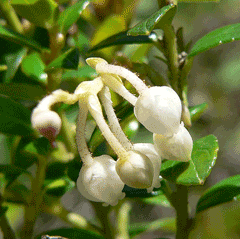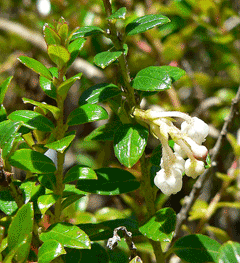 |
|
http://commons.wikimedia.org/wiki/User:Stan_Shebs |
 |
| http://commons.wikimedia.org/wiki/User:Stan_Shebs |
Translate this page:
Summary
Physical Characteristics

 Gaultheria myrsinoides is an evergreen Shrub growing to 0.2 m (0ft 8in) by 0.3 m (1ft).
Gaultheria myrsinoides is an evergreen Shrub growing to 0.2 m (0ft 8in) by 0.3 m (1ft).
See above for USDA hardiness. It is hardy to UK zone 9. It is in leaf all year, in flower from May to July. The species is dioecious (individual flowers are either male or female, but only one sex is to be found on any one plant so both male and female plants must be grown if seed is required). and is pollinated by Insects.
Suitable for: light (sandy) and medium (loamy) soils. Suitable pH: mildly acid soils and can grow in very acid soils.
It can grow in semi-shade (light woodland) or no shade. It prefers moist soil.
UK Hardiness Map
US Hardiness Map
Synonyms
Pernettya prostrata. (Cav.)DC.
Plant Habitats
Woodland Garden Sunny Edge; Dappled Shade; Ground Cover;
Edible Uses
Edible Parts: Fruit
Edible Uses:
Fruit - raw or cooked[177]. Up to 15mm in diameter[200].
References More on Edible Uses
Medicinal Uses
Plants For A Future can not take any responsibility for any adverse effects from the use of plants. Always seek advice from a professional before using a plant medicinally.
None known
References More on Medicinal Uses
The Bookshop: Edible Plant Books
Our Latest books on Perennial Plants For Food Forests and Permaculture Gardens in paperback or digital formats.

Edible Tropical Plants
Food Forest Plants for Hotter Conditions: 250+ Plants For Tropical Food Forests & Permaculture Gardens.
More

Edible Temperate Plants
Plants for Your Food Forest: 500 Plants for Temperate Food Forests & Permaculture Gardens.
More

More Books
PFAF have eight books available in paperback and digital formats. Browse the shop for more information.
Shop Now
Other Uses
A good ground cover plant for a sunny position or light shade, forming dense thickets[197]. Plants should be spaced about 1 metre apart each way[208].
Special Uses
Ground cover
References More on Other Uses
Cultivation details
Prefers a cool moist but not boggy humus rich soil in shade or semi-shade[11, 200]. A peat and moisture loving species, it requires a lime-free soil[11, 200]. Prefers a position in full sun, but it also tolerates light shade[11, 200]. This species only tolerates light and short-lived frosts so it is not very hardy in Britain. It can, however, be grown in a sheltered position outdoors in the mildest areas of the country[200]. Some forms have proved to be fairly hardy, surviving even cold winters in southern Britain and producing fruit[11]. There is some confusion over the naming of this species, the reports on the plants uses were listed under Pernettya prostrata and we are not sure that G. myrsinoides is the correct current name for the species. Closely related to G. pumila leucocarpa. This is an interesting plant for the rock garden. Dioecious. Male and female plants must usually be grown if seed is required. This species, however, does not need a male pollinator in order to fruit well. Plants in this genus are notably resistant to honey fungus[200].
References Carbon Farming Information and Carbon Sequestration Information
Temperature Converter
Type a value in the Celsius field to convert the value to Fahrenheit:
Fahrenheit:
The PFAF Bookshop
Plants For A Future have a number of books available in paperback and digital form. Book titles include Edible Plants, Edible Perennials, Edible Trees,Edible Shrubs, Woodland Gardening, and Temperate Food Forest Plants. Our new book is Food Forest Plants For Hotter Conditions (Tropical and Sub-Tropical).
Shop Now
Plant Propagation
The seed requires a period of cold stratification. Pre-chill for 4 - 10 weeks and surface sow in a lime-free compost in a shady part of the greenhouse and keep moist[78]. The seed usually germinates well, usually within 1 - 2 months at 20°c, but the seedlings are liable to damp off. Watering them with care and making sure they get ample ventilation will reduce this risk. Watering them with a garlic infusion can help to prevent damping off[K]. Prick out the seedlings into individual pots when they are about 25mm tall and grow them on in light shade in the greenhouse for at least their first winter[K]. Plant them out in late spring or early summer. The seedlings are susceptible to spring frosts and so it might be wise to give them some protection in their first spring or two outdoors.. Cuttings of half-ripe wood 3 - 6cm long, July/August in a frame in a shady position. They form roots in late summer or spring[78]. A good percentage usually take. Division in spring just before new growth begins. 'Drop' the plants 12 months earlier by digging them up and replanting them deeper in the soil so that the branches are buried and can form roots. This works best in a sandy soil[78]. It is best to pot up the divisions and grow them on in a lightly shaded position in the greenhouse until they are established. Plant them out in the summer. Layering in September/October. Takes 12 months[78].
Other Names
If available other names are mentioned here
Native Range
Coming Soon
Weed Potential
Right plant wrong place. We are currently updating this section.
Please note that a plant may be invasive in one area but may not in your area so it's worth checking.
Conservation Status
IUCN Red List of Threatened Plants Status :

Growth: S = slow M = medium F = fast. Soil: L = light (sandy) M = medium H = heavy (clay). pH: A = acid N = neutral B = basic (alkaline). Shade: F = full shade S = semi-shade N = no shade. Moisture: D = dry M = Moist We = wet Wa = water.
Now available:
Food Forest Plants for Mediterranean Conditions
350+ Perennial Plants For Mediterranean and Drier Food Forests and Permaculture Gardens.
[Paperback and eBook]
This is the third in Plants For A Future's series of plant guides for food forests tailored to
specific climate zones. Following volumes on temperate and tropical ecosystems, this book focuses
on species suited to Mediterranean conditions—regions with hot, dry summers and cool, wet winters,
often facing the added challenge of climate change.
Read More
Expert comment
Author
Kunth.
Botanical References
11200
Links / References
For a list of references used on this page please go here
Readers comment
| Add a comment |
|
If you have important information about this plant that may help other users please add a comment or link below. Only comments or links that are felt to be directly relevant to a plant will be included. If you think a comment/link or information contained on this page is inaccurate or misleading we would welcome your feedback at [email protected]. If you have questions about a plant please use the Forum on this website as we do not have the resources to answer questions ourselves.
* Please note: the comments by website users are not necessarily those held by PFAF and may give misleading or inaccurate information.
To leave a comment please Register or login here All comments need to be approved so will not appear immediately.
|
Subject : Gaultheria myrsinoides
|
|
|
|